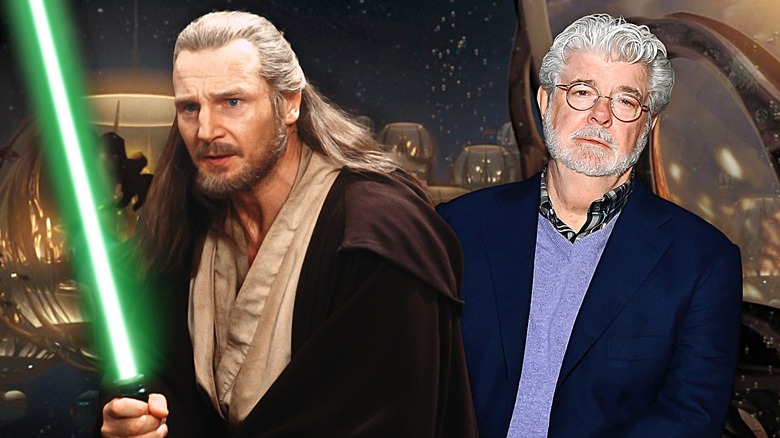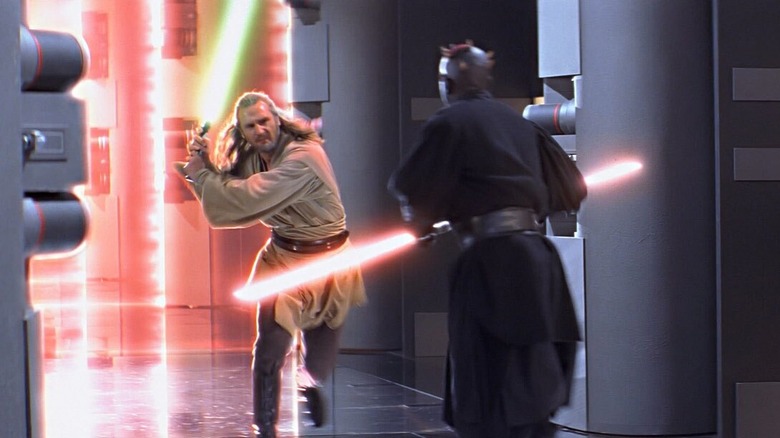The Real Reason George Lucas Killed Qui-Gon Jinn In Star Wars: The Phantom Menace
"Star Wars: Episode I" may have been a swing and a miss for many fans, but it has its fair share of iconic moments. Mysteriously titled "The Phantom Menace" (after its primary villain), the movie came out in 1999, resurrecting the "Star Wars" universe after a lengthy silence in the wake of 1983's "Return of the Jedi." The film backs up to tell the story of a young Anakin Skywalker's transformation into Darth Vader, and in the process, it introduces a cast of new characters, including Queen Amidala (Natalie Portman), Jar Jar Binks (Ahmed Best), and Qui-Gon Jinn (Liam Neeson). While most of these characters survive the first prequel installment, Neeson's character is a one-hit wonder who perishes in the film's final act — and it turns out that this wasn't random. George Lucas had a very specific reason for wanting to leave Qui-Gon behind.
In a 2019 interview posted on StarWars.com, Lucas and others looked back at "The Phantom Menace" two decades after its release. In his commentary, the famed sci-fi director has a thing or two to say about why he killed Qui-Gon and the importance of Darth Maul.
"I wanted to come up with an apprentice for the Emperor who was striking and tough," Lucas explained. "We hadn't seen a Sith Lord before, except for Vader, of course. I wanted to convey the idea that Jedi are all very powerful, but they're also vulnerable — which is why I wanted to kill Qui-Gon." Lucas provided further detail on the message the moment was supposed to send, adding, "That is to say, 'Hey, these guys aren't Superman.' These guys are people who are vulnerable, just like every other person."
Qui-Gon may be mortal, but his final duel was the ultimate sword fight
Qui-Gon Jinn's ultimate purpose in George Lucas' narrative may have been to make a point about the very real threat of the reemerging Sith in the first film, but that doesn't change the fact that Qui-Gon is a fierce fighter and that his final battle is one of the best moments in all of "Star Wars" lore. The epic duel is amazing to watch as Obi-Wan Kenobi (Ewan McGregor) and his Master take on Darth Maul (Ray Park).
The trio flips around the royal palace on Naboo as the two Jedi try to take down an opponent that does not blink. (You never noticed that about Darth Maul's scenes? Neither did we, at first.) In the end, Qui-Gon goes down first, only for his Padawan to triumph over his Sith opponent. Despite Qui-Gon's abrupt death, Lucas clarified that his ending wasn't purely to make a point about Sith skills. "We needed to establish that," he said, "but at the same time, we wanted the ultimate sword fight, because they were all very good." A bit later, Lucas added, "I had the fight continually move locations so that we had some room to do it on various sets, and that was really a callback to the Douglas Fairbanks / Errol Flynn movies, where you have a really long, intense sword fight."
Lucas also revealed a forward-thinking element of Qui-Gon's death when he said, "It sort of predisposes the sword fight between Anakin and Obi-Wan later on. There's real purpose to it. You have to establish the rules and then stick with them. The scene illustrates just how Jedi and Sith fight and use lightsabers."

